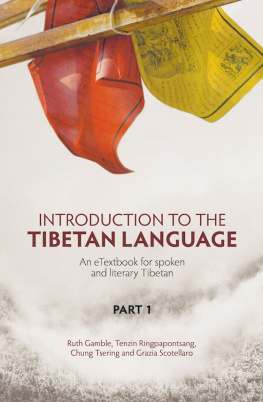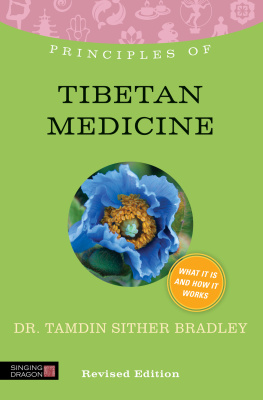Welcome
Welcome.1.Intro
The Course The Tibetan 1 and 2 courses will run for 12 weeks in first and second semester. To complete the courses, you will need to do the following every week: (1) Work through the assigned section of the eTextbook and the explanatory videos; (2) Attend an online tutorial; (3) Complete the assigned homework; (4) Mark the assigned written homework using the answers in the back of the eTextbook; (5) Scan or photograph your marked written homework, then upload onto Wattle these files along with recordings of your oral homework exercises.
You will generally be required to work through one lesson of the textbook every two weeks. The exceptions to this are Lessons Three and Seven in the first semester and Lessons Thirteen and Fourteen in the second semester. These lessons build on previous ideas rather than introducing completely new material and, therefore, should be completed in one week. There will also be three other assessments conducted during the semester, and you will be marked on your participation.
Assessment The assessment for the courses will typically consist of the following however consult your course outline to check what is the assessment as it can vary from year to year: (1) Weekly Homework 40% (2) Take-home test 20% (3) Final Assignment 30% (4) Participation 10%
Now let's work through them.
(1) Weekly Homework 40% Your Weekly Homework consists of the exercises at the end of each lesson. As has already been explained, most of the time you will be expected to finish a lesson every two weeks. The exercises are a bit different depending whether they are in the section of the eTextbook on learning to read and write (Lessons One and Two), colloquial sentence building (Lessons Three to Nine), or reading literature (Lessons Ten to Fourteen). In the first two of these sections, you will be required to both complete written exercises and record yourself reciting sounds or drilling sentences. In the reading literature section, you will not be required to make audio recordings of yourself.
After finishing these exercises, you should check the written section of your homework against the answers that are provided at the end of the eTextbook. You should then upload your marked written work and your voice recordings, if applicable, onto Wattle. One of the exercises each week will be to review the week's vocabulary by using Quizlet flashcards. A link to the Quizlet flashcards is embedded within the exercises. Once you follow this link, you will find a set of cards linked to each lesson.
(2) Take-home Test (48 hours) 20% Each semester, you will be required to complete a Take-home Test in the middle of the semester: at the end of week 6 in semester 1 and the end of week 7 in semester 2.
(2) Take-home Test (48 hours) 20% Each semester, you will be required to complete a Take-home Test in the middle of the semester: at the end of week 6 in semester 1 and the end of week 7 in semester 2.
In the first semester, the Take-home Test will cover Lessons One to Three. In the second semester, it will cover Lessons Eight to Ten. It will be made available on Wattle on the Thursday midnight of week 6 (semester 1) or week 7 (semester 2), and you will have until midnight Saturday to upload the completed test onto Wattle. Both tests will consist of three parts: A, B and C.
In Semester 1, these will consist of: Part A (40%): 20 simple Tibetan words will be written on the test sheet. You will have to: (1) recognise and translate these words; and (2) note any sound changes in each word.
You will receive 20 marks for translation and 20 marks for noting sound changes, making a total of 40 marks. Part B (30%): Listen to a recording of Tenzin reading out 15 words three times each. You must: (1) recognise the sounds (15 marks); and (2) translate the words (15 marks). Part C (30%): In the third section, you will be asked to: (1) translate a list of fifteen words (15 marks); and (2) record yourself saying these words (15 marks).
In Semester 2, the three sections will consist of: Part A (30%): You will be required to recognise and translate 15 simple sentences from colloquial Tibetan into English (2 marks per sentence). Part B (30%): You will be required to translate 10 simple sentences into Tibetan (3 marks per sentence).
Part C (40%): You will be required to answer 10 simple questions about yourself. These questions will be asked in Tibetan. You should (1) transliterate these sentences (10 marks); (2) write out your reply in Tibetan (10 marks); and (3) record your replies to them in Tibetan (20 marks, 2 marks per recording).
You must then scan and upload the test paper and any required audio recordings before the 48-hour deadline.
(3) Final Assignment 30% You will have two weeks to finish the Final Assignment after the last week of the class.
In Semester 1, these will consist of: Part A (30%): The translation of 15 Colloquial sentences into Tibetan (2 marks per sentence).
Part B (30%): The translation of 15 Colloquial sentences from Tibetan (2 marks per sentence). Part C (40%): You will be required to answer 10 questions that have been asked in Tibetan. You should (1) transliterate these sentences (10 marks); (2) write out your reply in Tibetan (10 marks); and (3) record your replies to them in Tibetan (20 marks, 2 marks per recording).
In Semester 2, the Final Assignment will consist of four parts: Part A (20%): The translation of 10 Colloquial sentences into Tibetan (2 marks per sentence). Part B (20%): The translation of 10 Colloquial sentences from Tibetan (2 marks per sentence). Part C (30%): The translation of 15 Literary sentences from Tibetan (2 marks per sentence).
Part D (30%): The translation of a short, Literary text.
(4) Participation 10% Your marks for participation will cover your preparation for and involvement in the online tutorials.
The eTextbook In this course, instead of attending a class in which we discuss elements of the Tibetan language, we have developed an eTextbook that imbeds descriptions and examples of the language in videos alongside their written descriptions. Hopefully, this will give you a chance to do a few things. First, it gives you the opportunity to listen to the information and reflect on the examples at your own pace. It also allows you to do it in smaller pieces; most of the explanatory videos are between 3 and 10 minutes long.
You can listen and re-listen to them as often as necessary. If you still have questions about what you are learning, you can then ask them in the online tutorials, via online class forums or through emails. You can also revisit previous explanations whenever you feel like it. It also means, however, that it is up to you how much time you dedicate to processing this information, and it is up to you to decide when you do it. We strongly suggest giving yourself three hours a week to work through the assigned section of the eTextbook. We also strongly suggest that you do this before you attend your online tutorial.
Preparing in this way will enable you to make the most of your tutors time. The eTextbook is divided into 14 lessons. These 14 lessons are in three sections:
- Lessons One and Two: learning how to read and write Tibetan;
- Lessons Three to Nine: learning how to make basic Colloquial Tibetan sentences;
- Lessons Ten to Fourteen: an introduction to basic Literary Tibetan structures.
In each lesson, you will find the following: (1) Either an introduction to a common phrase (Lessons One and Two), a recorded conversation (Lessons Three to Nine) or an introduction to and reading of a text (Lessons Ten to Fourteen); (2) The body of the lesson, which will introduce new elements, one after another; (3) Exercises that you need to complete for your homework; (4) Vocabulary, which are marked in blue within the lesson, and then given in a list at the end. At the beginning of Lessons Three, Six and Ten, you will also find between one and three sections that supply you with some grammatical background to what you are about to learn. Our approach to this grammar is that it is necessary scaffolding; you set it up so that what you are about to learn makes sense, and then when the language has become a habit, you will not need to think about it anymore. The lessons that contain these grammatical overviews are slightly longer than the other lessons, but they do not contain new structures that you have to memorise, so you won't have that much more to learn than in the other lessons.










